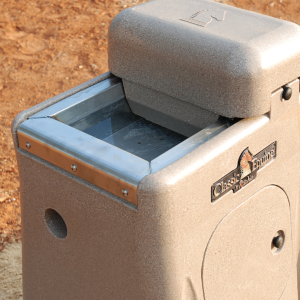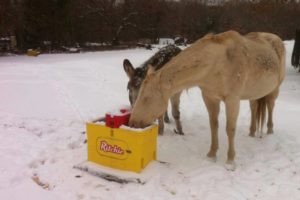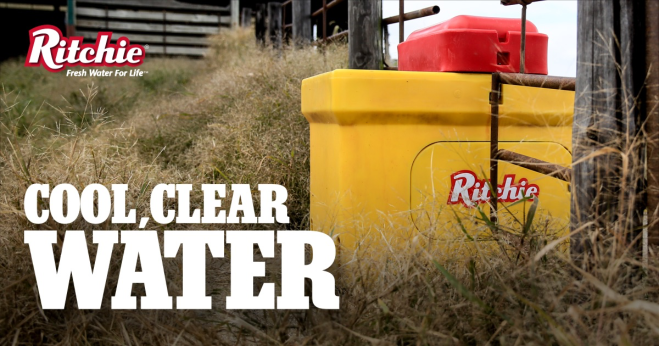Water Quality and Your Horse

In the attempt to solve any problem, it is inevitable that the solution will create a new problem. The art of good solutions is predicated on the new problem being more manageable or preferable to the original problem to which the solution was applied.
When we are talking about the methods, means and practical functions of keeping our animals hydrated, the problems and solutions create interesting scenarios that stress the best solution architects.
Water Source
Starting at the source is a wise idea. The most common source is surface water.
Surface water is a widely used source to provide water across the globe. Thousands of animal owners use the water that naturally exists on their property or will dig their own pond or reroute streams. The problem with surface water as your primary source is that it is far too often contaminated by the chemical runoff of the surrounding land. The higher concentration of chemicals, the more health issues will surface with your animals. The level of bacteria, viruses, protozoa, algae, and minerals present in surface water is typically higher than other sources. Contamination and stagnation are usually detected far too late so waterborne illnesses are more common with animals with surface water as their only source.
Surface water sources are also dependent on rain or on naturally occurring springs to provide a steady source. Drought, evaporation and water tables all vary and can leave you with a depleted source and this could occur rapidly. Flood and runoff also create a dilemma for relying on surface water alone as your source. The climate also affects this source. In warmer months the temperature can be a deterrent too.
On the positive side, surface water is the least expensive and is energy free.
Rainwater collection or rain harvesting is another source. This is not a new source but there is a popular movement to include this is in your strategy. While there are other reasons to consider this method, as a primary solution for watering animals it is an expensive source and does not solve many problems that animal owners face. If you are utilizing this source other reasons, then this can be a solution for you but it requires a large amount of planning, work and monitoring to make this a viable method of watering.
Well, municipal and community water or pressurized water supply. This is the most convenient source and the most prolific for watering animals. Pressurized water supply allows for faster recovery, diversity of trough placement, easier volume monitoring. These sources typically do not have the contamination factors that lead to health issues. This is not a perfect source and there are places where the well and or municipal source has a Ph balance or high mineral levels that need to be considered.
Water Temperature
We touched on it above when discussing surface water, but water temperature is an important element of your hydration strategy. While most have thought of the reality of freezing temperatures, warm temperatures also pose problems. In the warmer months there is a higher occurrence of algae growth, bacteria, and viruses. In hot climates, the water temperature reaches a point where the animals will not fully hydrate.
 In cold climates, the reality of freezing is something most are aware of. With freezing, it usually means an increase in labor and a most uncomfortable performance of your normal duties. If your habit is to fill buckets, fill troughs or “turn on” a source. Getting out in the elements is painful when it is 20º below zero. Breaking ice and dealing with busted hoses also creates a labor issue that far too many horse owners are familiar with.
In cold climates, the reality of freezing is something most are aware of. With freezing, it usually means an increase in labor and a most uncomfortable performance of your normal duties. If your habit is to fill buckets, fill troughs or “turn on” a source. Getting out in the elements is painful when it is 20º below zero. Breaking ice and dealing with busted hoses also creates a labor issue that far too many horse owners are familiar with.
Extreme cold water has a similar effect as extreme warm water. The animal tends to not fully hydrate. The goal is to have moderate water temperatures year round. Minimizing the volume of the immediate supply is a wise move in keeping the temperature within an optimal range. Choosing the right trough is the logical next step.
Troughs
All troughs are not equal. Large volume troughs, whether they are galvanized metal or rubber, are prone to become an algae factory. These troughs require regular cleaning and that is not easy and thus often ignored (I am guilty of procrastination). In cleaning these troughs there are several elements that lead to waste. To properly clean, all of the existing water must be removed and then replaced. Removing the algae and debris is difficult and time-consuming. Non-Insulated troughs degrade rapidly and are far too often used beyond their ability to function well.
Small troughs require multiple fills a day but are much easier to clean. For those who utilize pastures for most of the year, small passive troughs are not an option. With large troughs and passive troughs, the cleaning agents used to clean also need to be considered. The use of bleach for regular cleaning is a toxin. Many of the algae killing chemicals on the market are also toxic or lead to digestive issues which can cause dehydration.
Automatic troughs provide a solution that solve many of the problems that other troughs fail to remedy. The use of small volume automatic waterers is a solution for those who have pressurized water access. The small volume and demand feature of an automatic water is a solution that benefits all herd sizes and pasture configurations.
Conclusion
At Ritchie Industries, we have been dedicated to manufacturing waterers that are good for the animals, the animal owner and the environment. Considering all of the problems and options available to providing quality water to your horses we believe that we have the best resource for the most challenging scenarios. Whether you have one horse or 150, we have a watering solution that solves the problems outlined above.
Good resources:
http://equusmagazine.com/article/water_quality_082809?ctid=2
http://www.equinews.com/article/water-quality-for-horses
http://www.equinews.com/article/cleaning-horse-feed-tubs-and-buckets
http://www.sites.ext.vt.edu/newsletter-archive/livestock/aps-98_12/aps-1005.html
